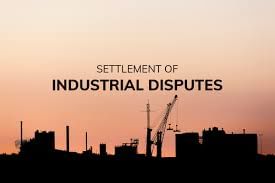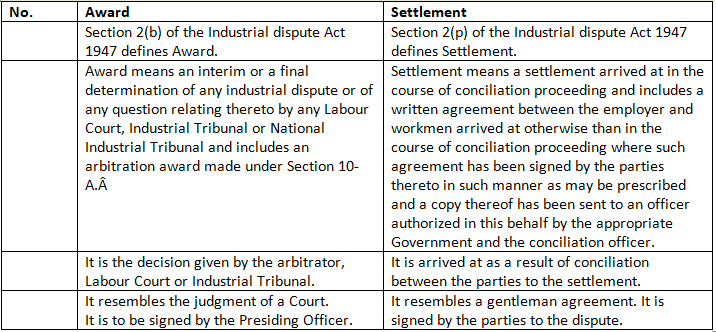Award & Settlement | Business Law - B Com PDF Download
| Table of contents |

|
| Introduction |

|
| Method of settlement of Industrial Dispute |

|
| What is award? |

|
| What is Settlement? |

|
| Period of operation of Awards and Settlement |

|
| Conclusion |

|
Introduction
The Industrial Dispute Act, 1947 which extends to the whole of India came into operation on the first day of April 1947. As per Preamble of the said Act, it is enacted to make a provision for the investigation and settlement of the dispute and certain other purposes such as recovery of money from the employer in terms of Settlement or Award by making an application to the appropriate government. The purpose and aim of the Industrial Disputes Act 1947 is to minimize the conflict between labour and management and to ensure, as far as possible, Economic and Social Justice. The act has made comprehensive provisions both for this settlement of disputes and prevention of disputes in certain Industries.
Method of settlement of Industrial Dispute

To protect the interests of both industry and the national economy, it is essential to maintain harmonious relations between employers and employees. To promote this industrial peace and cooperation, the Industrial Disputes Act offers several methods for resolving disputes:
1. Collective Bargaining
Collective bargaining is a key method for resolving industrial disputes and improving employer-employee relations. It involves direct negotiation between employers and employees (or their unions) to peacefully and voluntarily settle issues such as wages and working conditions, without involving any third party. Agreements reached through this process are known as bipartite settlements.
This approach is widely recognized as the most effective and preferred way to handle disputes, as it encourages cooperation and understanding. It is also viewed as a socially important right and is emphasized in India’s Five-Year Plans. The term "collective bargaining" was introduced by Sidney and Beatrice Webb in their book Industrial Democracy (1897). As defined by N.W. Chamberlain in 1958, it is a process where management and unions decide on the terms under which employees work.
2. Conciliation
Conciliation is a process where a neutral third party helps the disputing parties reach a mutual agreement. This third party may be a Conciliation Officer or a Board of Conciliation, as outlined in Sections 4 and 5 of the Act. The conciliator does not impose a decision but facilitates dialogue to help resolve the conflict amicably.
3. Voluntary Arbitration
Arbitration refers to the settlement of disputes outside the court system. When both parties agree, they can choose a mutually trusted individual (the arbitrator) to resolve the matter. The arbitrator examines the dispute and provides a decision known as an “award,” which is binding on both parties.
As per Section 10A of the Industrial Disputes Act, 1947, parties can enter into a formal arbitration agreement, which must follow a prescribed format and mention the names of the arbitrators. Arbitration provides a quicker, less formal resolution process compared to court proceedings.
4. Adjudication
When all other methods such as negotiation, conciliation, or arbitration fail, the last resort is adjudication, also called compulsory adjudication. In this method, the government refers the dispute to one of the statutory bodies for a formal decision.
These authorities include:
- Labour Courts (Section 7),
- Industrial Tribunals (Section 7A),
- National Tribunals (Section 7B).
These bodies have the authority to examine the dispute and pass a legally binding judgment, especially when mutual settlement seems unlikely.
What is award?
The judgment of an arbitrator is called his Award. Award (Judgement) of Arbitrators under section 10A is an Award.
Definition of Award
Section 2(b) of the Industrial Dispute Act, 1947 defines Award as follows - According to Section 2(b) of the Industrial Disputes Act, 1947 'Award' means an interim or a final determination of any Industrial Dispute or of any question relating thereto by any Labour Court, Industrial Tribunal or National Industrial Tribunal and includes an arbitration award made under section 10A.
Ingredients of Award
- An Award is an interim or final determination of an industrial dispute.
- It is an interim or final determination of any question relating to such dispute.
- Such interim or final determination is made by any Labour Court, Industrial Tribunal or National Industrial Tribunal.
- Award (Judgement) of Arbitrators under section 10A is an award.
What is Settlement?

According to Section 2 (p) of the Industrial Dispute Act, 1947 'Settlement' means a settlement arrived at in the course of conciliation proceeding and includes a written agreement between the employer and workmen arrived at otherwise than in the course of conciliation proceeding where such agreement has been signed by the parties thereto in such manner as may be prescribed and a copy thereof has been sent to an officer authorised in this behalf by the appropriate Government and the conciliation officer.
Procedure for Settlement of Industrial Disputes
The Industrial Disputes Act, 1947 outlines the procedure for resolving industrial disputes, particularly in “public utility services,” as defined in Section 2(n). This includes services like railways, postal, telegraph, telephone, supply of electricity, water, and light, systems of sanitation or conservancy, parts of industrial establishments vital for safety, and any industry declared by the government to be a public utility in times of emergency.
According to the Act, any industrial dispute must first go through conciliation before being referred to the proper adjudicatory authorities. If a dispute arises or is anticipated, a Conciliation Officer may initiate proceedings. In the case of a public utility service, and when notice has been served under Section 22, conciliation becomes mandatory.
Conciliation can begin when:
- A dispute already exists.
- There is a real possibility of a dispute arising.
- Both parties individually request the government to start conciliation.
The process officially begins when the Conciliation Officer issues a notice asking the parties to appear. The officer may meet the parties together or separately to facilitate discussions.
The Conciliation Officer must submit a report to the government within 14 days from the start of the proceedings. During this period, the officer works to help both parties reach a fair and peaceful resolution. If they succeed, a report along with a memorandum of settlement signed by both sides is submitted to the government.
This settlement becomes effective either from the date decided by the parties or from the date it is signed. It remains binding for six months, unless otherwise agreed. After this, it continues to be binding for an additional two months following any notice of termination given by either party.
The settlement is binding on:
- All parties involved in the dispute,
- The employer, including their heirs, successors, or assignees,
- All current employees at the time of the dispute,
- And any future employees who join the establishment later.
If no agreement is reached, the Conciliation Officer will submit a report to the government explaining why a settlement could not be achieved and providing all relevant facts of the case.
Action by the Government
On receipt of the report from the Conciliation Officer, the Government will come to a decision on whether the circumstances and the facts of the case as such to justify a further reference. The Government has to arrive at 'prima facie' conclusion that the nature of the dispute justifies a further reference.
Collective Bargaining as a method of Settlement of Industrial Disputes
Collective bargaining has become one of the most established and evolved methods for resolving industrial disputes in India since independence. It holds great importance for those committed to maintaining industrial peace and enhancing industrial productivity.
In earlier times, under a laissez-faire economic approach, employers had unrestricted authority to hire or fire workers. Their bargaining power was significantly stronger, allowing them to dominate negotiations with employees.
However, the adjudicatory system—often criticized for being slow, costly, and affected by governmental delays and unpredictable outcomes—has led many to view direct negotiations as a more effective method for resolving major issues like wages and working conditions.
Collective bargaining is a widely accepted approach in industrially advanced nations. Instead of focusing on individual employment contracts, these countries emphasize collective agreements made through negotiations with representative groups of workers.
The Industrial Disputes Act, 1947 provides the legal framework and machinery for the resolution of industrial conflicts, supporting the use of such methods as part of India's labour law system.
Distinction between Award and Settlement

On whom Awards and Settlements are binding
- A settlement arrived at by agreement between the employer and workman otherwise than in the course of conciliation proceeding shall be binding on the parties to the agreement.
- Subject to the provisions of sub-section (3), an arbitration award which has become enforceable shall be binding on the parties to the agreement who referred the dispute to arbitration.
- A settlement arrived at in the course of conciliation proceedings and an award of a Labour Court, Tribunal or National Tribunal shall be binding on:
- All parties to the industrial dispute;
- All other parties summoned to appear in the proceedings as parties to the dispute;
- Where a party is an employer, his heirs, successors or assigns;
- All persons who were employed in the establishment or part of the establishment on the date of the dispute.
Penalty for breach of Settlement or Award
If any person who commits breach of any terms of a settlement or Award is liable for punishment. The punishment provided for is imprisonment which may extend to 6 months or with fine or with both.
Period of operation of Awards and Settlement
Section 19 of the Industrial Disputes Act, 1947 outlines the duration for which a settlement or award remains in force.
A settlement takes effect either on the date agreed upon by the disputing parties or, if no such date is specified, on the date the memorandum of settlement is signed. The settlement remains binding for the duration agreed by the parties. If no duration is mentioned, it is considered binding for six months from the date of signing. After this period, the settlement will continue to remain in force until two months have passed from the date one party gives written notice of its intention to end the settlement.
An award, on the other hand, remains effective for one year from the date it becomes enforceable under Section 17A. However, the appropriate government has the power to either shorten this period or extend it—one year at a time—provided that the total duration does not exceed three years from the date the award took effect.
If the appropriate government feels that there has been a significant change in circumstances since the award was made, it may refer the award—or a part of it—to the relevant Labour Court, Tribunal, or National Tribunal. This is done to decide whether the operational period of the award should be reduced. The decision made by the court or tribunal in such a case will be final.
Conclusion
A settlement is a mutual agreement reached between the parties involved in a workers' compensation case—this includes the injured employee, the employer, and the workers’ compensation insurance provider (unless the employer is self-insured). This agreement functions as a contract and may prevent the employee from claiming additional compensation for the same injury in the future.
An award, however, is issued by a workers’ compensation court. It may cover medical treatment or other compensation depending on the injury. For example, a judge may grant, or an insurance provider may accept responsibility for, benefits related to temporary or permanent disability. This process does not require the worker to give up any legal rights, nor is a settlement agreement needed to receive these benefits.
If you are uncertain whether you have received a settlement or an award, legal assistance is available. Professionals can assess your case, explain your legal choices, and guide you before you agree to a settlement or accept an award. Their role is to ensure that you receive the complete and fair benefits entitled to you under Colorado’s workers’ compensation regulations.
As per Section 2(p) of the Industrial Disputes Act, 1947, a settlement refers to: An agreement reached during a conciliation process, or A written agreement between the employer and employees made outside the conciliation process, provided that it is signed in the prescribed manner and a copy is submitted to the designated government officer and the conciliation officer.
|
30 videos|99 docs|17 tests
|
FAQs on Award & Settlement - Business Law - B Com
| 1. What is the difference between an award and a settlement in legal terms? |  |
| 2. How are settlements typically reached in legal disputes? |  |
| 3. What factors influence the amount awarded in a legal case? |  |
| 4. Are settlements legally binding? |  |
| 5. Can a settlement be appealed? |  |














